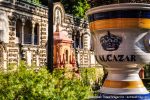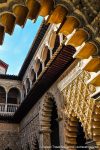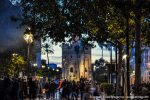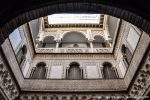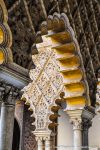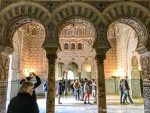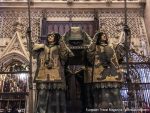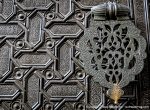Seville is a dynamic tapestry of eastern and western architecture and culture. For hundreds of years it was the capital of Moorish dynasties with Arab names like the Abbasids, Almoravids and the Almohad. This 2.200 year-old jewel has undergone just as many changes with its culture, as it has with its architecture and even its name. Let us follow in the Footsteps of the Moors and discover the best things to see in this ancient capital:
- Gardens of the Royal Alcazár in Seville
- The intimate space of the Mezquita of Córdoba
- Moorish architecture perfected the art of patios and fountains
- View from Generalife to Alhambra – all in Granada
- The height of Moorish architecture: The Nasrid Palace in Alhambra
Seville
The ancient (probably Phoenician) Spal became the Latin Hispalis, then the Arab Ishbiliyya and finally, the Spanish Sevilla. While the original, Moorish architecture of Córdoba and Granada (Alhambra) remained largely unspoilt by later centuries, there’s actually surprisingly little architecture left from the 500 years of Moorish reign in Seville. The few original remains are Palacio del Yeso in the Alcázar, the city walls, the Torre del Oro and parts of the cathedral, like the main section of the Giralda – the bell tower.
But even though few original buildings are left, the Moors left an unmistakable characteristic to the city: a handicraft heritage, that was past down through generations of Mudéjars (unconverted Muslims) and Moriscos (converted Muslims) who were hired by the later kings and lords to build magnificent buildings, like the Alcázar of Seville.
- The gardens of the Alcázar were made to resemble paradise on earth
- The Mudéjar ornamentation of the Salón de Embajadores is awe-inspiring
- The bell tower – Giralda – with its Moorish base and Renaissance top
- View to the Cathedral courtyard from the belfry Giralda
- Mudéjar artisans certainly did their best at Patio de las Doncellas
After the Reconquista – the Christian reconquering of the Iberian peninsula – Seville became home to the Castilian Royals, and parts of the Alcázar are still used by the Royal family, making the Alcázar the oldest functioning royal palace in Europe. The Cathedral was built between 1402 and 1506 and converted the former Muslim minaret to a Christian bell tower, now known as the Giralda.
After Columbus had discovered America in 1492, Seville was given the monopoly for trade with the Spanish colonies in the Americas and began its Golden Age. One of the architectural legacies of this era is the Renaissance Archivo General de Indias, also on the UNESCO World Heritage list and the enormous Royal Tobacco Factory – Real Fábrica de Tabacos – that was built in 1728. The city also has many Baroque churches and buildings, which gives this ancient Moorish capital a unique architectural landscape.
- Torre del Oro was built by the Almohad dynasty as a watchtower in the early 1200
- The Royal Tobacco Factory – Real Fábrica de Tabacos – was built in 1728
- Baroque entrance to the enormous Royal Tobacco Factory
- Parts of the Alcázar are still used by the Royal family, making the Alcázar the oldest functioning royal palace in Europe
- The Plaza de España from 1928 mixes Renaissance and Mudéjar architecture
- The Cathedral dates back to the 15th century, but part of the bell tower is much older
- The Renaissance Archivo General de Indias is also on the UNESCO World Heritage list
Real Alcázar de Sevilla
The precursor of Seville’s Alcázar was probably founded in the beginning of the 10th century, to function as government buildings for the Caliph of Cordoba of the Umayyad dynasty. Later on, the Abbasid dynasty, who ruled Seville during the 10th century, added a new Alcázar – a Royal House – to the government buildings. The Almoravid dynasty in the 11th century closed down the government offices in order to expand the royal palace and the Almohad dynasty in the 12th century added yet more buildings to this patchwork of different Arab architectural styles.
- Entrance to Salón de los Embajadores from Patio de las Muñecas
- The intimate Patio de las Muñecas
- Engravings with poetry and quotes from the Koran
- Palacio del Yeso is the oldest part of the Alcázar and the only part original Moorish
- Amazing woodwork at the ceiling at the Patio de las Doncellas
- Patio de las Doncellas is one of the most beautiful examples of Mudéjar architecture in the Alcázar
- The peaceful Patio de Levíes in the Casa del Asistente
Unfortunately, the Palacio del Yeso is all that remains from these Arab dynasties. The Alcázar you see today is actually much newer, because although the Christian monarch banned Islam when they reconquered Seville in 1248, they took the Arab design and architecture to heart and made additions to the Alcázar, that nowadays most people think are from Moorish times.
The most precious palace in the Alcázar is the Palacio del Rey Don Pedro, and this was built in the end of the 14th century by the Christian king Pedro I. To be fair – he didn’t build it. Instead, his good Muslim friend, the Emir of Granada, Muhammed V, sent his best artisans to the king and helped Pedro build the most beautiful example of Mudéjar style in the world. Remember, that Granada was still Muslim until 1492 and the alliance between a Muslim and Christian ruler was quite unusual at that time. Muhammed did owe Pedro a large favour, since the Christian king had lured the usurper Mohammed VI to Seville and cut of his head, ensuring the throne would yet again belong to Muhammed V.
- Details of the arches framing the Patio de las Doncellas
- Salón de los Embajadores was definitely made to impress and provoke
- The Gardens of the Alcázar were used as set for the popular TV series Game of Thrones
- The symmetry and elegance of Patio de las Doncellas is out of this world
- The hypnotizing and extremely beautiful ceiling of Salón de los Embajadores
- Salón de los Embajadores was used as public reception space
- While Patio de las Doncellas was a public space, the Patio de las Muñecas was a private one
The Palacio del Rey Don Pedro is popularly known as Palacio Mudéjar and here, you can find the most exquisite Mudéjar architecture such as Patio de las Doncellas, Patio de las Muñecas and Salón de los Embajadores. The other parts of the Alcázar have Gothic and Renaissance architectural features and especially the gardens are just magical. So magical, that they were used as set of the fifth season of TV-series Game of Thrones.
More information about the Alcázar:
Seville Cathedral
Construction of the mosque, preceding the Cathedral, began in 1184 under the Almohad dynasty and ended 15 years later. After the reconquista, the mosque was consecrated and used as church until it was destroyed by an earthquake in 1356. Only three parts of the original Moorish structure remain: The imposing, yet light and elegant Puerta del Pérdon, which leads to the Patio de los Naranjos. The central fountain of the patio, which again incorporates a font from the former 6th century Visigothic cathedral. And the belfry Giralda, which used to be a minaret 2/3 the height of the present structure.
After the Christians reconquered Seville, they used the minaret as bell tower and when the building of the new Cathedral began in 1402, they incorporated the bell tower in the Cathedral structure. But it wasn’t until the Renaissance, that the last 1/3 was added in 1568.
- Los tres principales estados de la torre de Sevilla, 1909, autor Alejandro Guichot (Museo de Artes y Costumbres Populares de Sevilla)
- Construction of this Moorish minaret began in 1184 under the Almohad dynasty
- The name of the bell tower comes from the weathervane statue on the top of the belfry, which in Spanish is called a “giraldillo”
- You can climb the belfry and be awarded with views to the gargoyles
- The Cathedral itself is enormous!
- Columbus is buried here ..or part of him!
- The original Moorish Puerta del Perdón leads to the courtyard and is one of the few remains from the 12th century mosque
- The original great doors of the Moorish Puerta del Perdón are made from larchwood covered with bronze
The name of the bell tower comes from the weathervane statue on the top of the belfry, which in Spanish is called a giraldillo.
If you’re interested in more history about the Moorish influence on Andalucia, follow us In the Footsteps of the Moors: Cordoba, where we discover the enigmatic Mosque–Cathedral and the shady patios.
More information about Seville’s Cathedral:
Learn more





